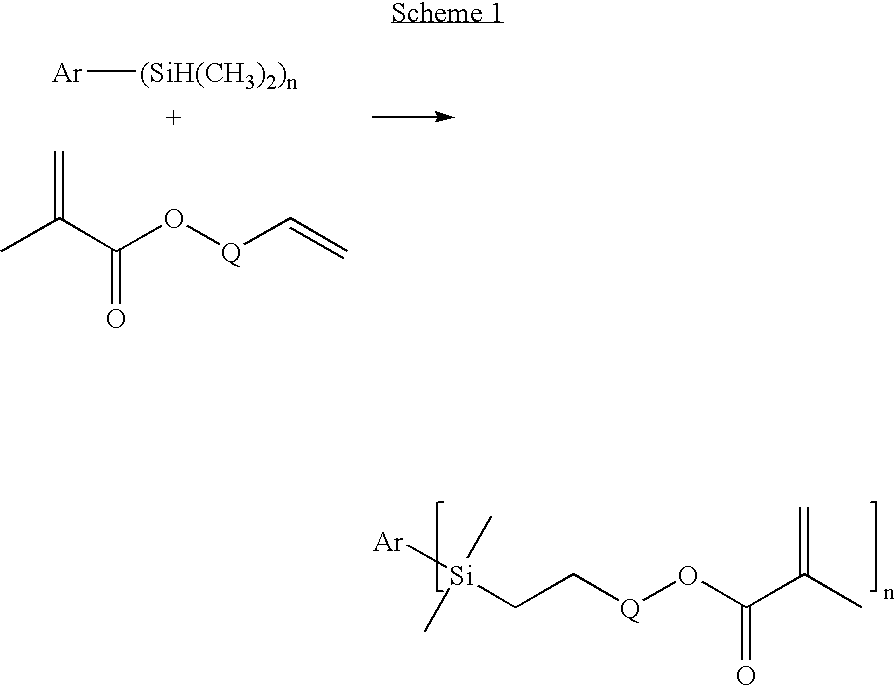Dental Compositions Containing Carbosilane Monomers
- Summary
- Abstract
- Description
- Claims
- Application Information
AI Technical Summary
Benefits of technology
Problems solved by technology
Method used
Image
Examples
example 1
Synthesis of 1,4-bis-(dimethyl-[3-(methacryloyloxy)propyl]silyl)benzene (p-PDA)
[0092] A mixture of 1,4-bis-dimethylsilylbenzene (Gelest, Tulleytown, Pa.) (5.00 g, 25.7 millmole (mmol)), allyl methacrylate (Sigma-Aldrich) (6.49 g, 51.4 mmol), toluene (20 milliliter (ml)), and two drops of a solution of platinum—divinyltetramethyldisiloxane complex in xylene (Gelest) was mixed at room temperature for 17 hours. The resulting mixture was loaded onto a silica gel column and eluted with a mixture of ethyl acetate (20 volume percent (vol %)) in hexane (80 vol %). The solvent was evaporated to yield the product as a colorless oil (7.80 g) having a MW of 446.74 and a viscosity of 136 cP. Characterization of the oil by 1H Nuclear Magnetic Resonance Spectroscopy (NMR) and Infrared Spectroscopy (IR) spectra was consistent with the p-PDA structure.
example 2
Synthesis of 1,4-bis-(dimethyl-[2-(5 / 6-methacryloyloxy-bicyclo[2.2.1]hept-2-yl)-ethyl]silyl)benzene (p-PDN)
[0093] A mixture of 1,4-bis-dimethylsilylbenzene (3.77 g, 19.4 mmol), 2-(5 / 6-methacryloyloxy-bicyclo[2.2.1]hept-2-yl)ethene (prepared according to Example 14 in U.S. Pat. No. 3,927,116 (Rick et al.)) (8.00 g, 38.8 mmol), toluene (15 ml), and two drops of a solution of platinum—divinyltetramethyldisiloxane complex in xylene was mixed at room temperature for 24 hours. The resulting mixture was loaded onto a silica gel column and eluted with a mixture of ethyl acetate (30 vol %) in hexane (70 vol %). The solvent was evaporated to yield the product as a colorless oil (11.07 g) having a MW of 603.06 and a viscosity of 7411 cP. Characterization of the oil by 1H NMR and IR spectra was consistent with the p-PDN structure.
example 3
Synthesis of 1,3-bis-(dimethyl-[2-(5 / 6-methacryloyloxy-bicyclo[2.2.1]hept-2-yl)-ethyl]silyl)benzene (m-PDN)
[0094] A solution of 1,3-dibromobenzene (Sigma-Aldrich) (30.00 g, 0.13 mole (mol)) in dry tetrahydrofuran (65 ml) was added dropwise over one hour to a mixture of chlorodimethylsilane (Sigma-Aldrich) (40.10 g, 0.42 mol), dry tetrahydrofuran (100 ml), and magnesium turnings (24.31 g, 0.13 mol). After full addition, the mixture was refluxed for 2 hours. The solvent was then removed under vacuum and the residue was diluted with hexane (200 ml). The solid was washed two times with hexane (200 ml) and filtered. The combined hexane solutions were concentrated under vacuum, and the residue was distilled under reduced pressure (47-49° C. at 2 mm Hg, 267 Pascals) to yield 1,3-bis-dimethylsilylbenzene as a colorless oil (17.41 g).
[0095] A mixture of 1,3-bis-dimethylsilylbenzene (3.77 g, 19.4 mmol), 2-(5 / 6-methacroyloxy-bicyclo[2.2.1]hept-2-yl)ethene (8.00 g, 38.8 mmol), toluene (20 ml)...
PUM
| Property | Measurement | Unit |
|---|---|---|
| Shrinkage | aaaaa | aaaaa |
| Compressive stress | aaaaa | aaaaa |
| Compressive stress | aaaaa | aaaaa |
Abstract
Description
Claims
Application Information
 Login to View More
Login to View More - R&D
- Intellectual Property
- Life Sciences
- Materials
- Tech Scout
- Unparalleled Data Quality
- Higher Quality Content
- 60% Fewer Hallucinations
Browse by: Latest US Patents, China's latest patents, Technical Efficacy Thesaurus, Application Domain, Technology Topic, Popular Technical Reports.
© 2025 PatSnap. All rights reserved.Legal|Privacy policy|Modern Slavery Act Transparency Statement|Sitemap|About US| Contact US: help@patsnap.com



